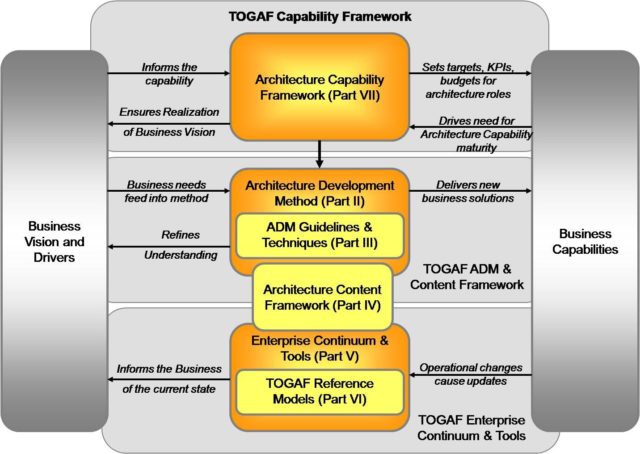TOGAF Framework

The Open Group Architecture Framework (TOGAF) is a framework for Enterprise Architecture that provides an approach for designing, planning, implementing, and governing an enterprise information technology architecture. TOGAF defines an enterprise as “any collection of organization that has a common set of goals” and the purpose of EA “to optimize across the enterprise the often fragmented legacy of processes into an integrated environment that is responsive to change and supportive of the delivery of the business strategy”
Why use TOGAF? It’s currently the most adopted and accepted methodology for Enterprise Architecture. So by using the concepts given by TOGAF, integration with other parties will (in time) become more standarized.
TOGAF has been developed through the collaborative efforts of over 300 Architecture Forum member companies from some of the world’s leading companies and organizations. Using TOGAF results in enterprise architecture that is consistent, reflects the needs of stakeholders, employs best practice, and gives due consideration both to current requirements and the perceived future needs of the business. Developing and sustaining an enterprise architecture is a technically complex process which involves many stakeholders and decision processes in the organization. TOGAF plays an important role in standardizing and de-risks the architecture development process. TOGAF provides a best practice framework for adding value, and enables the organization to build workable and economic solutions which address their business issues and needs.
TOGAF consists of three main parts:
- The TOGAF Architecture Development Method (ADM), which explains how to derive an organization-specific enterprise architecture that addresses business requirements.
- The Enterprise Continuum, which is a “virtual repository” of all the architecture assets – models, patterns, architecture descriptions, etc. – that exist both within the enterprise and in the IT industry at large, which the enterprise considers itself to have available for the development of architectures. At relevant places throughout the TOGAF ADM, there are reminders to consider which architecture assets from the Enterprise Continuum the architect should use, if any.
- The TOGAF Resource Base, which is a set of resources – guildelines, templates, background inofrmation, etc. – to help the architect in the use of the ADM.
In order to successfully operate an architecture function within an enterprise, it is necessary to put in place appropriate organization structures, processes, roles, responsibilities, and skills to realize the Architecture Capability.
References
Scott A. Bernard . (2012).An Introduction to Enterprise Architecture . 03 th Edition. Authorhouse. Bloomington. ISBN: 978-1-4772-5800-2 .
Cs.tlu.ee. (2018). Cite a Website – Cite This For Me. [online] Available at: http://www.cs.tlu.ee/instituut/oppe_materjalid/magister/2005/Andro_Kull/Togaf_8.pdf [Accessed 22 Jan. 2018].


